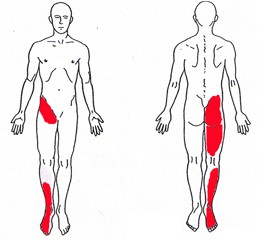
2014-8-13

Case Sharing
Ms. Cai, who is 22 years old, hurt her low back and buttocks by accident in May 2014. There was no obvious pain that day, but two days later, she felt pain in the low back, buttocks, and groin area, and there were some symptoms of numbness in the feet, especially the sacroiliac joint pain. When she sits down or lies on the bed, she feels her low back muscles tightening.
After that, Ms. Cai consulted a doctor to take anti-inflammatory medicine, but because the medication caused the patient to have stomach pain, dizziness and nausea, the doctor stopped the patient’s medication and referred to the author for conservative chiropractic treatment. After correcting the sacroiliac joint, the patient’s low back pain, groin pain and foot numbness have been greatly improved.
The structure of the sacroiliac joint
By connecting the left and right ilium, left and right ischium, left and right pubis and sacrum to form a ring structure (Figure 1). The bone is a skeleton between the body and the lower limbs to support the body’s pillars. There are two sacroiliac joints which form a stable framework with the pubic joint in front. (Figure 2).
The surface of the sacroiliac joint is not smooth, but irregular. Although the surface is not flat, the concave and convex surfaces of the sacrum and the ilium are in perfect fit. This sacroiliac joint can slide and rotate in a small range. But with age, the activity of this joint will be greatly reduced.
The sacroiliac joint is stabilized by the surrounding ligaments and muscles, so if the ligament is strained or inflamed, the sacroiliac joint will be painful due to instability. The most common are women in late pregnancy, postpartum women (due to hormones that greatly increase the activity of the sacroiliac joints), and people doing excessive stretching.

Symtoms of Sacroiliac Joint Syndrome
Generally, patients suffering from Sacroiliac Joint Syndrome can accurately point out that the source of the pain is on the sacroiliac joint. Usually, there’s a feeling that the buttocks muscles are tense and contracted. When sitting down, the pain in the buttocks increases, and sometimes it extends to the hip joint, the outer side of the calf, and even the feet and toes. The most obvious is the pain when the patient lifts the leg and puts on the socks. And difficulties. Some patients even feel that they have long and short feet. These symptoms are often misdiagnosed as sciatica, herniated disc, acute low back pain, or bone spurs.

Causes
The most common causes of sacroiliac joint pain are falls, straining the ligament; turning around to move heavy objects; poor sitting posture (for example: sitting around with the legs crossed, sitting upright, turning around to play on the computer, etc.); pregnant women and postpartum women .
Treatment
Chiropractors will use manual therapy to correct the subluxation of the sacroiliac joints, ice therapy, and other alternative treatments to help reduce inflammation and relieve pain in the affected area. It will also guide the patient to correct posture and exercise to strengthen and consolidate the peripheral ligaments and muscles.

 Book an Appointment
Book an Appointment


